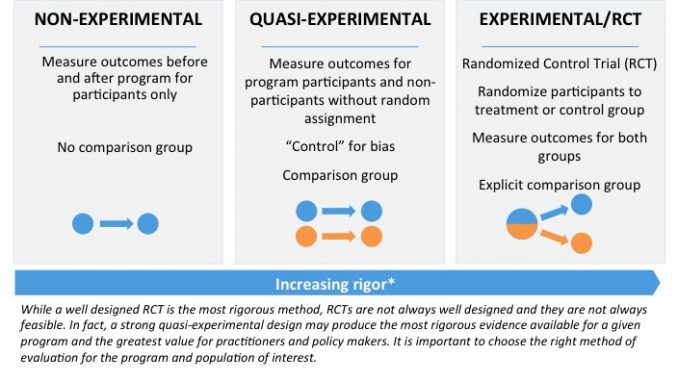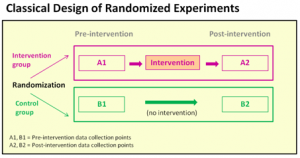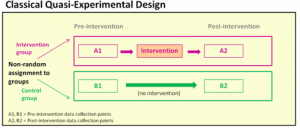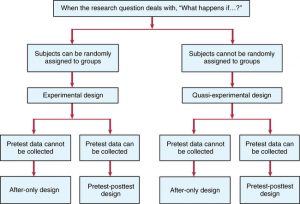
There are multiple similarities and differences between Randomized Controlled Trial and Quasi Experimental Studies.
Table of Contents
Similarities between RCT and quasi-experiments are:
- These are both experimental study designs
- Study participants in both studies are subjected to some type of treatment/intervention and control group
- Some outcome of interest is measured
- The researchers test whether differences in this outcome are related to the treatment/intervention or not.
However, there are some major differences between these two studies.


20 major differences between RCT and quasi-experimental studies are:
S.N. |
Randomized Controlled Trial (RCT) |
Quasi-experimental Studies |
| 1. | RCT is an experimental study design where the subjects in a population are randomly allocated to different groups | Quasi Experimental is an experimental study design where the subjects in a population are non-randomly allocated to different groups |
| 2. | Also known as randomized study | Also known as non-randomized study |
| 3. | Study populations are selected randomly | Study populations are chosen |
| 4. | Randomization is the main ingredient of RCT | Randomization is not the main ingredient of Quasi-experimental |
| 5. | RCTs are always prospective | These studies are generally prospective in nature |
| 6. | It uses truly random method of allocating participants to different groups | It uses quasi-random method of allocating participants to different intervention groups i.e. the method of allocating is not truly random |
| 7. | Have high scientific validity | It has moderate scientific validity |
| 8. | It provides the best scientific evidence to any study | Evidences generated from this design are relatively of low significance while compared to RCT |
| 9. | It is considered as a ‘Gold Standard’ against which other research designs should be judged. | It is not considered as a ‘Gold Standard’ |
| 10. | It is considered as an ideal design for evaluating both the effectiveness and side effects of interventions | It is not considered as an ideal design for evaluating both the effectiveness and side effects of interventions |
| 11. | The major strength of this study design is that it avoids any possibility of selection bias in the trial | The major strength of this study design is that it is practicable in all context and can ensure ethical considerations at all times |
| 12. | RCT can be used up to a point unless there is any real-world constraint for random assignment | Quasi-experimental design is used when real-world constraints like ethical, political or logistical constraints do not allow for randomization |
| 13. | It can be used to assess and strongly claim the causal effect of any programs, policies or interventions | It cannot be used to assess and strongly claim the causal effect of any programs, policies or interventions |
| 14. | RCT, also known as true experiment has probability samples | Quasi-experiment has non-probability samples |
| 15. | RCTs cannot be conducted and are not realistic at all times due to some practical or ethical reasons E.g.: while conducting studies related to exposure of harmful chemicals, we cannot randomize people to receive the harmful chemicals. | It can be conducted without violating ethical considerations |
| 16. | These are generally quite expensive | These are generally less expensive |
| 17. | Random assignment in RCT neutralizes factors other than the independent and dependent variables, which makes it possible to directly infer cause and effect
|
We can claim causality in quasi-experimental studies. However, we can never be certain that we have controlled for all confounding sources |
| 18. | RCT increases the likelihood that the groups will be comparable in terms of variables that we recognize and measure along with in terms of variables that we cannot recognize and may not be able to measure | In quasi-experiment we can increase the likelihood that the groups will be comparable in terms of variables that we recognize and measure but not in terms of variables that we cannot recognize and may not be able to measure |
| 19. | RCT provide chances to control for unobserved biases, with an assumption that randomization was free from bias | Quasi-experiment provides less chances to control for unobserved biases |
| 20. | It has less potential for bias, or confounding, and study validity is not compromised | It has relatively increased potential for bias, or confounding, and study validity is compromised |

References and for More Information:
https://www.nber.org/reporter/summer03/angrist.html
https://www.sri.com/research-development/randomized-controlled-trials-quasi-experimental-designs
https://medium.com/netflix-techblog/quasi-experimentation-at-netflix-566b57d2e362
https://www.researchconnections.org/childcare/datamethods/experimentsquasi.jsp
https://www.ncbi.nlm.nih.gov/pmc/articles/PMC2446460/
https://www.airmedicaljournal.com/article/S1067-991X(06)00286-0/pdf
http://samples.jbpub.com/9780763789961/89961_CH03_Macha.pdf
https://www.annualreviews.org/doi/pdf/10.1146/annurev-publhealth-040617-014128
http://www.understandingresearch.com/glossary/study-design-terms
https://www.med.uottawa.ca/sim/data/Study_Designs_e.htm
https://www.unicef-irc.org/KM/IE/img/downloads/Quasi-Experimental_Design_and_Methods_ENG.pdf
https://www.ncbi.nlm.nih.gov/pmc/articles/PMC5669452/
http://www.scielo.sa.cr/scielo.php?script=sci_arttext&pid=S2215-35352015000200020
https://qualitysafety.bmj.com/content/qhc/12/1/47.full.pdf
http://www.bandolier.org.uk/booth/glossary/RCT.html